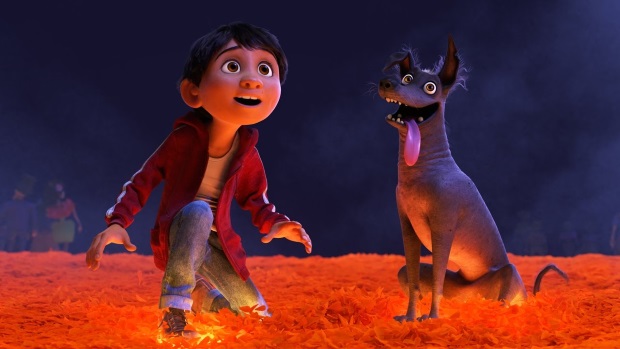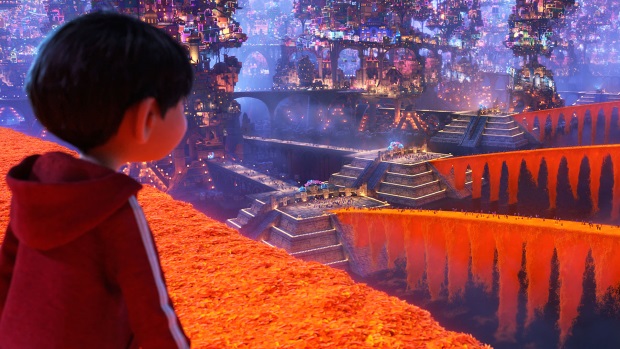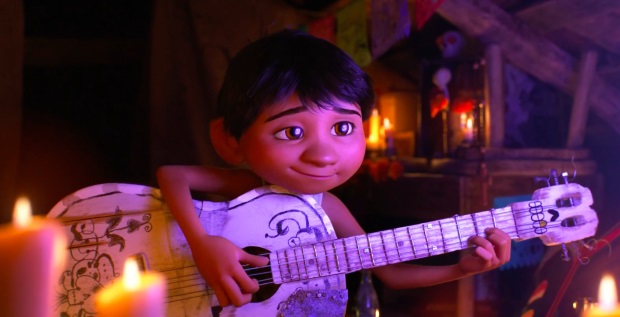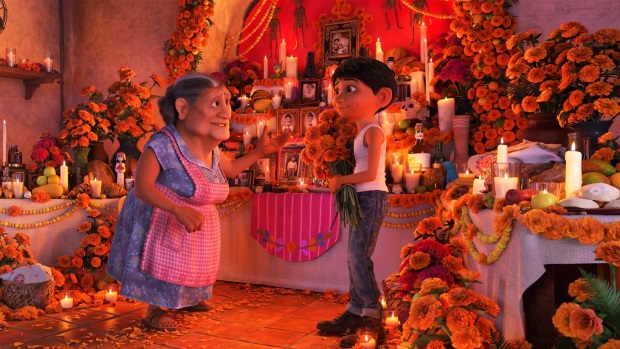Lee Unkrich interview: directing Coco
Pixar's Lee Unkrich chats directing Coco, Calvin & Hobbes rumours, The Shining and more...
Last summer, I was lucky enough to speak with Adrian Molina, co-director of Pixar’s jaw-droppingly beautiful Coco. Now that the film is complete, the film’s other director, Lee Unkrich, also found time for a chat. Here’s what he had to tell me about Kubrick’s Col Legno, the influence of live-action filmmaking techniques on his animation, and even his encounters with Calvin and Hobbes’ creator Bill Watterson…
Adrian Molina, your co-director is not here. What do you think he would want us to know if he was?
Adrian being Mexican-American himself has a lot of pride in having been a vital part of the making of this film. We all feel a lot of pride for how we depicted Mexican culture and the Latino community but I know that Adrian particularly does. For myself, not being somebody who is Latino, if I had messed up and gotten it wrong I would have gotten everything that I deserved; for Adrian, being Mexican-American himself, it would have been that much worse. He has enormous pride in this film. He wanted to work on it from the moment I started talking about wanting to make it and I’m so glad he rose through the ranks and became a part of it.
Thinking about the process by which animated films are put together and the processes more familiar to an editor of live action, as you were before your work at Pixar, I wonder if you ever cut ‘coverage’ the way you might in live action? Do you ‘overshoot’ and get the animators to leave handles on shots?
I do, to a degree. Earlier on the process, when we’re first working out all of the camerawork, at that stage, we very much have coverage, lots of different angles.
At the layout stage?
Yeah, that’s when we very much create footage that the editor can work with like ‘coverage.’ Once we nail that down we don’t want to waste the animator’s time, what they do is so time consuming and meticulous, it would be pretty wasteful to have them animate big handles onto each shot. That being said, often while we’re animating I’ll ask animators to extend a shot a little bit because I can see already I can’t tell exactly where I want to cut the shot and it will be good to have some wiggle room. At that point, when an animator has already down a whole shot it’s relatively trivial for them to extend by half a second or whatever.
But yes, at the back end of the process, when we’re really nailing down, tightening up the movie, I’m very much looking at it like a live action editor. I can’t swap to a whole different take of a shot at that point because it doesn’t exist but I do do a lot of tightening and frames can make a lot of difference. I’ll do what I call a belt-tightening pass where I pull that belt one notch tighter.
That’s right at the end as you picture lock it?
Right before we send off to Michael Giacchino to score.

I understand you come from Chagrin Falls, which I’m familiar with a little bit. Did you ever encounter Chagrin-native and Calvin and Hobbes creator Bill Watterson in real life?
I did. He grew up there. I didn’t know him. He was older than me. I think he graduated in ’77-ish, he’s about 8 years older than me. But here’s how I encountered Bill. In my sophomore algebra class I was sitting next to a bookcase filled with all of the Yearbooks through time. The Yearbook for the year that Bill graduated, the whole cover was covered in his cartoons, and all throughout the Yearbook were strips he’d done about the teachers. He hadn’t done Calvin and Hobbes at the time I was looking at this. In my mind he was just this cool kid who could draw really well and had a great sense of comics. Then, also, when I was in 8th grade, the art teacher brought Bill in to talk to the class. At that time he was doing political cartoons for the town paper. She had him come in and he did drawings for us all day. I still remember the drawings he drew for me. I wish I still had them. But when you’re in 8th grade… well, they were taped to the wall next to my bed somewhere and then they vanished into the ether.
There’s a reference online, which I’m dubious of, that clearly claims Pixar wanted the rights to do a Calvin and Hobbes movie. Is that true or misreporting?
No, that’s not true. But I discovered around Toy Story 3 that I had some friends in common with him, friends I went to school with who have older siblings who went to school with Bill. I wrote him an e-mail – he’s famously reclusive, I was not expecting a response but he was very kind and did write back to me and said he was a big Pixar fan, loved the work that we did. Which is great.
I’ve never gotten together with him but my friend and colleague Pete Docter did. Many of us at Pixar are big fans of Bill’s. It’s really cool that I grew up in the same town as him.
As I understand it you’re not a draftsman yourself, not so much, and for an animation director that’s less common.
I did draw a lot growing up and I wanted to be an artist but around high school I took this right turn into filmmaking and I never really stuck with my art. My artistic abilities froze where they were in high school. I was voted most artistic in senior class and everybody thought I was going to be an artist but I just didn’t. And now, I really don’t like to draw much at work where everybody around me is so good. It’s weird to go from being the kid who could draw, that’s what I was known for, to now where I don’t partake of that.
Does it impede on the process that you tend not to draw at work?
I’ll jump in where I can. A lot of times I’ll do really rough sketches for how I want a shot composed, or talking to a storyboard artist. I’m able to get the idea across then other people can run with it and turn it into something magical. It helps. I have a visual sense. I had a lot of different interests as a kid and I’ve found that what I’m doing now is the culmination of those things. I used to draw, do photography, I used to act. All of those came together.

Talking of photography, sometimes the replication or faking of photographic depth of field in this film is absolutely stunning.
We don’t even need to fake it anymore. We’ve developed a camera system that does what it needs to do. I’m able to, say, string some lights in the back of the shot because they’re going to be out of focus and look really lovely. Back in the day we really had to fake it, throwing things off into planes and throwing them out of focus manually. Now the camera system understands depth of field and f-stops and we’re able to get more of a real-life look in our images.
And though you could, you tend not to break it.
That’s been important to me from the very beginning. Back on Toy Story I ended up being a big part of establishing a lot of the camerawork and it seemed to me, when I looked at a lot of CG animation at that time, the cameras were flying around all over the place, it was very undisciplined. I thought it was not off-putting but it was hard for the audience to relate to. At that time, in ’95, if we’re going to be introducing this whole new look for a movie into the world, it would be important to ground it as much as possible in established film grammar. To give a sense of somebody operating the camera, bound by real-world rules. We don’t stick to that 100% in everything we do. We do sometimes get crazy with the virtual camera.
But there does seem to be a box of virtual prime lenses and a virtual zoom.
We literally do that. In the computer you could set your lens at any millimetre but we try not to do that, to have a fixed kit of primes.
Can you give an example of why you sometimes break that?
I dunno, we sometimes eke open a shot a little bit, if it’s not quite right, to get the framing just right. In general it does us well to be bound by the usual rules. Our films are of a certain style, this is just what we do, a house style of sorts. We like creating worlds that are very different from what you have seen but they’re made believable.
The guitar playing in this film is a great example of believability and verisimilitude. It’s extremely convincing. How did it work? Is any of it procedural? And how good a guitarist is Miguel in this film?
He’s meant to be pretty good. I didn’t want him to be a prodigy but I wanted to sell the idea that he’s put a lot of time into studying Ernesto de la Cruz. I wanted all of the musical instrument playing to be accurate because we could make it accurate – it would be extra work but we’ve all seen movies where actors don’t really play or their hands are just out of frame and think ‘He’s not actually playing that, is he?’ Occasionally you see a bit where an actor has learned how to play a piece and it’s impressive and helps with the believability. From very early on we talked about how to make the playing as accurate as possible so any time we recorded music on the guitar we had cameras filming it from many angles, we’d strap a GoPro onto the neck of the guitar, and capture every detail of the playing. Then the animators would use that as reference.

We tried to steer animators who are guitar players themselves onto those shots because they’d have the sensitivity to the playing. There was some procedural work done in making the guitar strings vibrate properly, so it’s a combination of technical innovation and the artistry of the actors.
Early on when we see the choreographed scene with the dancers, can you explain how much of that is modular stuff?
They’re all doing essentially the same choreography, though I think at moments it’s broken out into different rows doing different things, so we were able to choreograph and animated one set, and that was propagated through the various dancers. We’d make adjustments to each so it didn’t feel robotic and lock-step, I wanted that feel of them being real people. So we started with one set of animation, roll that out to the group then introduced details and variations on a dancer by dancer basis.
Everybody knows you are a big fan of The Shining. What have you learned as a filmmaker from that film, or from Kubrick?
Probably a lot of things but if I were to boil it down, it’s probably his precision as a filmmaker. There’s almost nothing in his films that’s not meticulously thought-through. Everything is on screen for a reason, which taught me to think about where I would put the camera and what lens I would be using. He very much cared about these things. There’s a tension to his compositions… you know when you’re watching a Kubrick film, right? So what is that? That’s created by a combination of things. His sound design. His eye for composition. Part of why I love The Shining so much is just that I saw it when I was 12 years-old, a formative time in my life. It made me want to make movies myself.
Did you watch it in a hidden shrine, on a black and white set from VHS, like Miguel in Coco?
Not quite like that, but I would have wanted to if I could have.
Kubrick’s sound design and music is so interesting and well thought out. David Lynch is somehow the same way – he soundscapes have a way of unsettling you. There’s something about them, the way they’re mixed. I’m constantly thinking about both of them, really – David Lynch and Kubrick.
Can you give me an example of a good piece of sound in Coco where you’re particularly pleased with its effectiveness?
I’ll probably think of a better answer after we’re done but I do know that I wanted there to be an authenticity to this film. Even though it’s animated, I wanted people to feel like they were really in Mexico. I sent our sound designer Chris Boyes and his son down to Mexico and they recorded a ton of material in cemeteries, parades and shopping centres. I recorded a lot too, myself, when I was down there and a lot of that ended up being part of the soundscape of the film. I hope we’ve done an effective job.

Is there a characteristic to this sound that you thought was essential?
In terms of echoing Kubrick I’d like to say there was a playing technique that Kubrick used a lot in The Shining called Col Legno, where they turn the bow around. Players don’t like to do it because it’s bad for the bows. We did do that. I had Thomas Newman do it in Finding Nemo where Marlin and Dory first come to the trench. We leaned into that there because, to my taste, that sound is unsettling. We did do that at one point in Coco…
I shall challenge the readers to go and find it. Thank you very much, Lee Unkrich.
Coco is in UK cinemas from Friday.